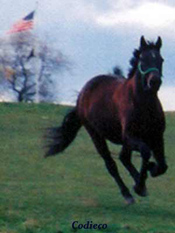
Horse Slaughter
Horse Cruelty
Horse Rescue
Horse Statutes
Horse Transport
Legislation
Stolen Horses
Press
General
SiteIndex
Double Deck Trailers
- Bottom Deck
- Doghouse
- Nose Deck
- Top Deck
Transport Company Safety Records
State Transport Laws
AZ Law
CA Law
CT Law 1976
MA Law 1977
MD Law 2006
MN Law 1983
NY Law 1980
PA Law 2001
RI Law 2008
VA Law 1987
VT Law
PA Horse Transport Law Cards
Transport Related Violations
PSP Enforcement at New Holland
Federal Law
Commercial Transportation of Horses to Slaughter
Proposed Legislation
IN Horse Transport Law SB86
EPN Testimony
Shop online at IGive.com with over 400 great stores you know & love- including Back In the Saddle! Up to 26% of the purchase price is donated to the EPN!
The EPN gets $5 extra the first time you shop!
PayPal accepts credit cards! Please send your tax deductible donation to the:Equine Protection Network, Inc.,
P. O. Box 232, Friedensburg, PA, 17933.
Shop for CD's at CDRush.com & the EPN Benefits!
Put "EPN" in the Coupon Code box when you place your order.
Now you can save money on your favorite music and help the horses at the same time!
HoofPAC is the political action committee that has been formed to end the slaughter of America's horses. Cathleen Doyle, founder of HoofPAC, led the successful Save The Horses campaign in 1998 that made the slaughter of California's horses a felony.

VA RULES AND REGULATIONS GOVERNING THE TRANSPORTATION...
Agency 5 - DEPARTMENT OF AGRICULTURE AND CONSUMER SERVICES
Chapter160
Research and Practice References
13 Am Jur 2d, Carriers §§241-242, 244, 321, 346-363, 367, 378.
5A Am Jur Pl & Pr Forms (Rev), Carriers, Forms 451-455.
35 Am Jur Proof of Facts 2d 607, Misrepresentation in Sale of Animal.
2VAC5-160-10. Definitions.
The following words and terms, when used in this chapter, shall have the following meaning, unless the context clearly indicates otherwise:
"Carrier" means the operator of any airline, railroad, motor carrier, shipping line, or other enterprise which, for hire, is engaged in the business of transporting any animal.
"Foal" means any horse suckling its dam.
"Horse" means those members of the genus Equus, including Equus caballus, asses, mules and hinnies.
"Mare" means a female horse.
"Pony" means a small horse standing 14.2 hands or less.
"Stallion" means an uncastrated male horse.
"Vehicle" means any machine, tractor, trailer, semi-trailer, or any combination thereof propelled or drawn by mechanical power and used upon the highways in the transportation of property.
Statutory Authority
§3.1-796.67 of the Code of Virginia.Historical Notes
Derived from VR115-02-14 §1; eff. May 13, 1987.
2VAC5-160-20. Application of this chapter.
The provisions of this chapter shall apply to loads of more than six horses being transported to a commercial slaughter facility in a vehicle.
Statutory Authority
§3.1-796.67 of the Code of Virginia.
Historical Notes
Derived from VR115-02-14 §2; eff. May 13, 1987.
2VAC5-160-30. Vehicles.
Vehicles transporting horses as set forth in 2VAC5-160-20 shall: 1. Be designed and constructed so that they can:
a. Be cleaned and disinfected;
b. Withstand the action of the weather; and
c. Withstand the weight of any horse which may be thrown against them;
2. Have more than one tier holding horses only if the tier is designed, constructed, and maintained to withstand the weight of the horses held by it;
3. Provide a minimum distance of 12 inches between the withers of each horse and the roof, provided that the minimum distance should only apply in so far as it permits every horse being transported to stand in its natural position;
4. Have rigid sides and suitable overhead protection;
5. Have at least two doorways for animal ingress and egress that:
a. Shall be on different sides of the vehicle;
b. Allow a minimum of 12 inches above the withers; and
c. Allow the largest horse to pass through without injury;
6. Be designed, constructed and maintained to ensure adequate and suitable ventilation for each horse;
7. Be equipped with permanently fitted shields that fully cover the projection of the wheel arches into the interior of the vehicle and prevent injury to horses;
8. Be free from any sharp edges or projections in the vehicle interior;
9. Protect all electrical fittings and wiring to prevent any horse from contact with them;
10. Be provided with a means of artificial lighting, fixed or portable, and capable of illuminating the interior to facilitate proper horse care;
11. Be designed to facilitate the inspection of the interior of the vehicle from the outside;
12. Have floors which, to ensure horses a proper foothold, are:
a. Covered with nonskid rubber or other material secured to the floor;
b. Constructed with metal grade floors with dull surfaces; or
c. Strewn with adequate amounts of sand or other nonskid substances;
13. Be provided with sufficient tying points when transporting horses which need to be secured; and
14. Have partitions:
a. As necessary to separate horses named in 2VAC5-160-80 and to comply with subdivision 4 of 2VAC5-160-60:
b. Constructed and maintained to withstand the weight of any horse which may be thrown against them;
c. Constructed to ensure that any gap which is left between the lower end of the partition and the vehicle floor will not result in injury to the limb of any horse; and
d. Of a height of at least 50 inches.
Statutory Authority
§3.1-796.67 of the Code of Virginia.
Historical Notes
Derived from VR115-02-14 §3; eff. May 13, 1987.
2VAC5-160-40. Loading and unloading.
Horses shall be loaded and unloaded in a vehicle such that:
1. A ramp, fitted or strewn with a nonskid material, shall be provided if the vertical distance from the trailer to the loading platform is greater than 15 inches;
2. No horse is caused injury or suffering by:
a. The excessive use of any device for driving horses; or
b. Contact with any part of the vehicle or accessory carried within;
3. Horses shall be tied as necessary;
4. In vehicles containing more than one tier, the weight of the horses upon the tier shall not be greater than the amount of weight the tier can support;
5. No untied horse, other than a mare with foal, shall be carried in the same compartment with any tied animal;
6. Each horse is adequately supported against the motion of the vehicle; and
7. Each group of horses set forth in 2VAC5-160-80 shall be separated from every other group by means of a partition.
Statutory Authority
§3.1-796.67 of the Code of Virginia.Historical Notes
Derived from VR115-02-14 §4; eff. May 13, 1987.
2VAC5-160-50. Cleaning and disinfection.
All vehicles shall be thoroughly cleaned and disinfected after each use.
Statutory Authority
§3.1-796.67 of the Code of Virginia.Historical Notes
Derived from VR115-02-14 §5; eff. May 13, 1987.
2VAC5-160-60. Protection during transport.
To ensure the well-being of the horses transported under the provisions of this chapter:
1. No horse shall be caused suffering owing to exposure to the weather;
2. Each horse shall have an adequate supply of fresh air;
3. The driver or an attendant shall be responsible for proper care, feeding and watering of the horses; and
4. A partition shall be placed, without causing overcrowding, to ensure that horses are not thrown about when the number of horses carried is less than the number which could be accommodated.
Statutory Authority
§3.1-796.67 of the Code of Virginia.Historical Notes
Derived from VR115-02-14 §6; eff. May 13, 1987.
2VAC5-160-70. Food, water and exercise.
In transit, any horse subject to this chapter shall be:
1. Offered potable water at least every 24 hours;
2. Fed every 24 hours; and
3. Unloaded and exercised every 24 hours.
Statutory Authority
§3.1-796.67 of the Code of Virginia.
Historical Notes
Derived from VR115-02-14 §7; eff. May 13, 1987.
2VAC5-160-80. Grouping of horses for transport.
Horses shall be grouped such that:
1. Each individual horse of the following categories shall have a separate stall during transport:
a. An injured or physically disabled horse;
b. A stallion, unless sedated;
c. An aggressive horse; and
d. A mare in season;
2. Each mare with a foal at foot shall travel with that foal, but separated from all other animals; and
3. Except for those horses listed in this section, a horse belonging to a specific group below may travel with others of that same group, but separate from all other groups:
a. Foals of any description under nine months of age;
b. Horses and ponies over nine months of age and standing less than 15 hands high (less than 60 inches to the withers);
c. Horses and ponies over nine months of age and standing 15 hands or taller (60 inches or greater to the withers).
Statutory Authority
§3.1-796.67 of the Code of Virginia.Historical Notes
Derived from VR115-02-14 §8; eff. May 13, 1987.
2VAC5-160-90. Injured or physically disabled horses.
Injured or physically disabled horses shall be protected by the
following: 1. No horse which is injured or disabled shall be permitted by its owner or his agent, or by the consignor, carrier, or other person in charge of the horse, to be transported or, where a journey has commenced, to be further transported if by reason of its unfitness, the horse is likely to be subjected to additional suffering;
2. No horse likely to give birth in the course of a proposed journey shall be permitted by its owner or his agent, or by the consignor, carrier or other person in charge of the horse to undertake that journey;
3. The person in charge of a horse which becomes unfit in the course of a journey shall ensure that it is not transported for a period longer than is necessary to transport it to the nearest available place at which it can receive veterinary medical attention; and
4. Special care shall be taken when loading injured or physically disabled horses to prevent additional suffering.
Statutory Authority
§3.1-796.67 of the Code of Virginia.
Historical Notes
Derived from VR115-02-14 §9; eff. May 13, 1987.
PA
Horse Transport Law Cards | NY
Horse Transport Law Card | Rhode Island Horse Transport
Law Card |
|
||||||||||
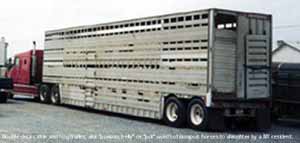 |
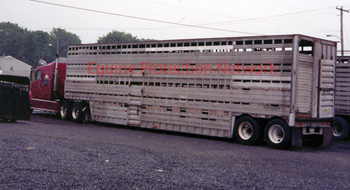 |
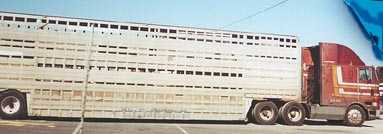 |
The trailer pictured BELOW, is
a straight deck SINGLE tier trailer.
This is NOT a double decker,"possum
belly" or "pot".
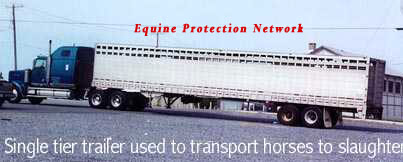
This
is a single tier trailer
used to transport horses
to slaughter. The truck is
a Western Star conventional
with a sleeper.
This is NOT a double decker or a "possum
belly".
Save America's Horses!
Contact us to find out how you can have our billboard near you!
|
Please send your tax deductible donation to: Equine Protection Network, Inc., P. O. Box 232, Friedensburg, PA, 17933 |
||
Save America's Horses- Make the Commitment to Your Horse! |
||
|
Photos On This Page CANNOT be Used Without Written Permission |
||

